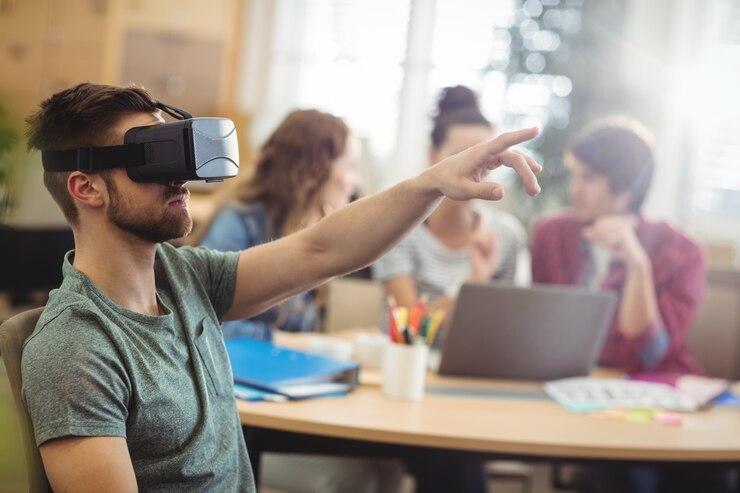Virtual Reality (VR) is no longer a futuristic concept; it has become an integral part of how we interact with technology, education, and the world. With advancements in hardware, software, and content development, VR education has transformed from an experimental tool into a mainstream educational medium. The question is no longer whether VR can influence education, but rather what’s next in virtual reality education? This article delves into emerging trends, cutting-edge applications, and the challenges facing this revolutionary approach to learning.
Revolutionizing Learning Through Immersive Experiences
VR is changing how students perceive and engage with learning. Immersive environments transport students beyond the limits of traditional classrooms, enabling them to explore new realities, from walking on Mars to studying anatomy inside the human body. This shift fosters deep understanding, allowing students to grasp abstract concepts more effectively.
For example, in STEM (Science, Technology, Engineering, Mathematics) fields, VR provides hands-on learning without physical constraints. Students can experiment with virtual physics labs or design engineering projects in real-time, bridging the gap between theoretical learning and practical application. Similarly, humanities courses leverage VR to reimagine historical events, enabling learners to witness pivotal moments in history as if they were there.
Key Technologies Driving VR in Education
The proliferation of VR in education owes its growth to significant advancements in technology. Notable innovations include:
- Standalone VR Headsets: Devices such as the Meta Quest series have eliminated the need for expensive PCs or external sensors, making VR more accessible.
- Haptic Feedback and Motion Tracking: These enhancements add a layer of realism, enabling users to interact with virtual environments in tangible ways.
- AI-Powered Personalization: Artificial intelligence is now integrating into VR systems to adapt learning content based on individual needs, ensuring tailored education for every student.
- Cloud VR Platforms: Cloud-based solutions have made it possible to deliver VR content on-demand, reducing costs and barriers to access.
These advancements are the backbone of modern VR education, creating an ecosystem where innovation and accessibility go hand in hand.
Bridging the Gap Between Accessibility and Quality
While VR education is transformative, questions of accessibility remain critical. How do we ensure that schools, particularly in underserved areas, can leverage this technology? Industry players are addressing this concern through partnerships with educational institutions and government bodies. Affordable headsets, open-source content, and subsidized programs are some of the measures gaining traction.
For students needing extra help with their studies, modern online platforms offer comprehensive solutions. Services like Pay Someone to Take My Exam for Me provide tailored assistance, ensuring students achieve their academic goals while balancing other priorities. These platforms are bridging the gap for students who may struggle with traditional methods, offering support alongside immersive VR learning.
Applications Across Diverse Disciplines
The versatility of VR is its strongest asset, extending its benefits across various fields of study:
Medical and Healthcare Training
Medical education has been revolutionized by VR. Students can now perform virtual surgeries, practice emergency response scenarios, and visualize human anatomy in ways that textbooks cannot replicate. The ability to simulate real-life medical conditions reduces risks associated with traditional training methods, ensuring professionals are better prepared.
Language Learning
Language learners benefit immensely from VR’s immersive capabilities. With virtual environments replicating native-speaking contexts, students can practice conversations, understand cultural nuances, and build confidence in real-time interactions. This practical exposure accelerates fluency, making language acquisition both efficient and enjoyable.
Environmental and Earth Sciences
VR enables students to study ecosystems, explore geological phenomena, and engage in conservation efforts virtually. Imagine investigating coral reefs or understanding the effects of deforestation firsthand, all while sitting in a classroom.
Vocational Training
Trades such as welding, automotive repair, and electrical work are adopting VR for training. Virtual workshops simulate real-world scenarios without the cost or risk of physical materials, allowing students to master techniques safely and effectively.
The Role of Collaboration and Social Learning
Another exciting development in VR education is the emphasis on collaboration. Multi-user VR environments allow students to interact, work on projects, and solve problems together. This fosters teamwork and communication skills, which are essential for professional success. Social VR platforms like Engage and AltspaceVR are designed for educational collaboration, making learning interactive and engaging.
Challenges and Future Prospects
Despite its immense potential, VR education faces several challenges. High costs, technical issues, and a steep learning curve for educators are barriers that must be addressed. However, ongoing research and development are paving the way for solutions:
- Reducing Costs: Affordable hardware and open-source software are emerging to democratize access.
- Professional Development for Teachers: Training programs are helping educators effectively integrate VR into their curriculums.
- Content Standardization: Ensuring consistency and quality across VR educational resources is critical for long-term success.
Looking ahead, experts predict a surge in mixed reality (MR) applications, blending virtual and augmented realities for seamless educational experiences. Additionally, blockchain-based credentialing within VR systems could transform how certifications are issued and verified.
The evolution of virtual reality in education represents a paradigm shift, one that is reshaping how we learn and teach. By embracing VR’s immersive capabilities, we are breaking down barriers, creating equal opportunities, and preparing students for a technology-driven future. As advancements continue, the possibilities are limitless—transforming education from a static experience into a dynamic journey of exploration and discovery.
